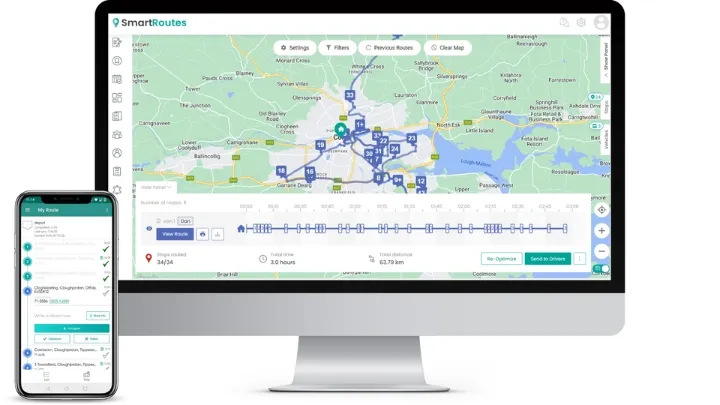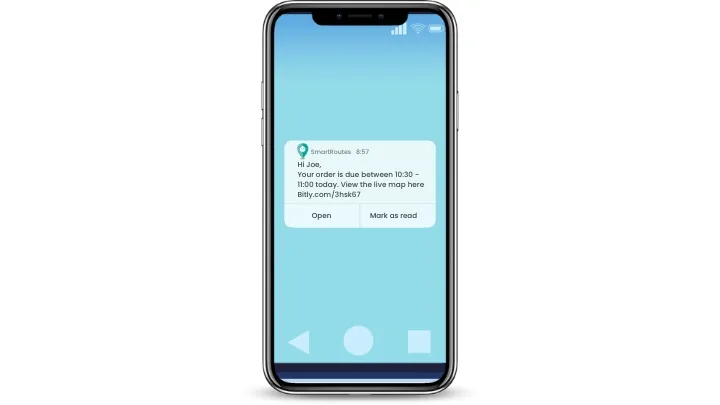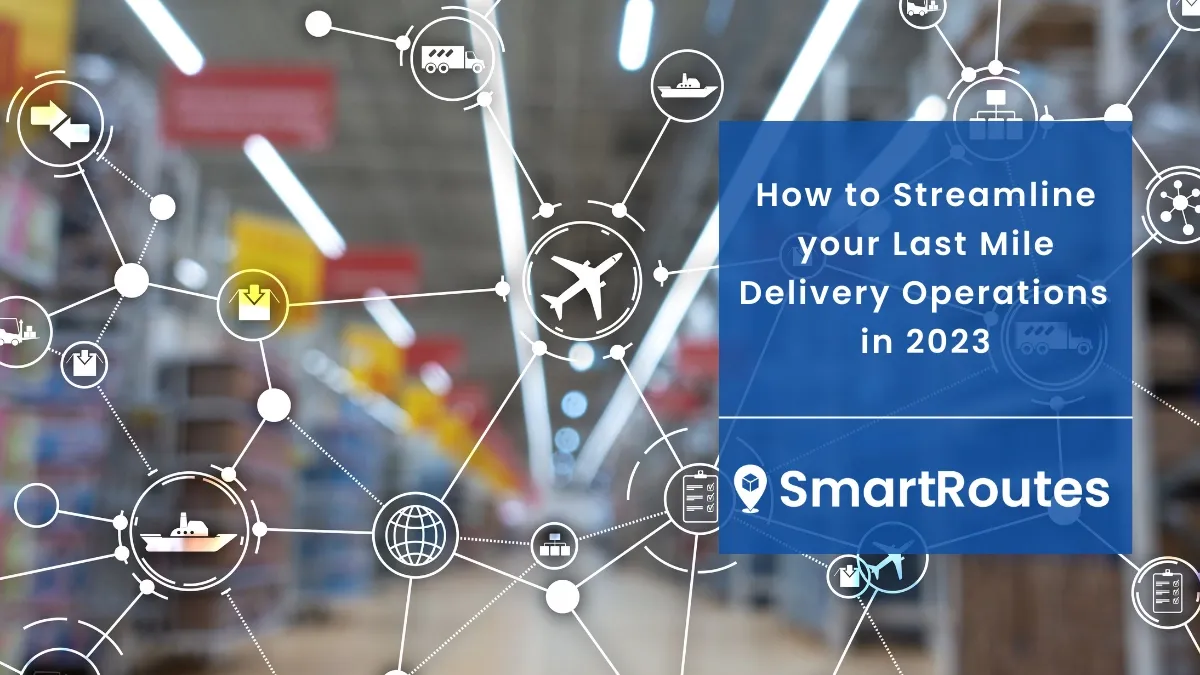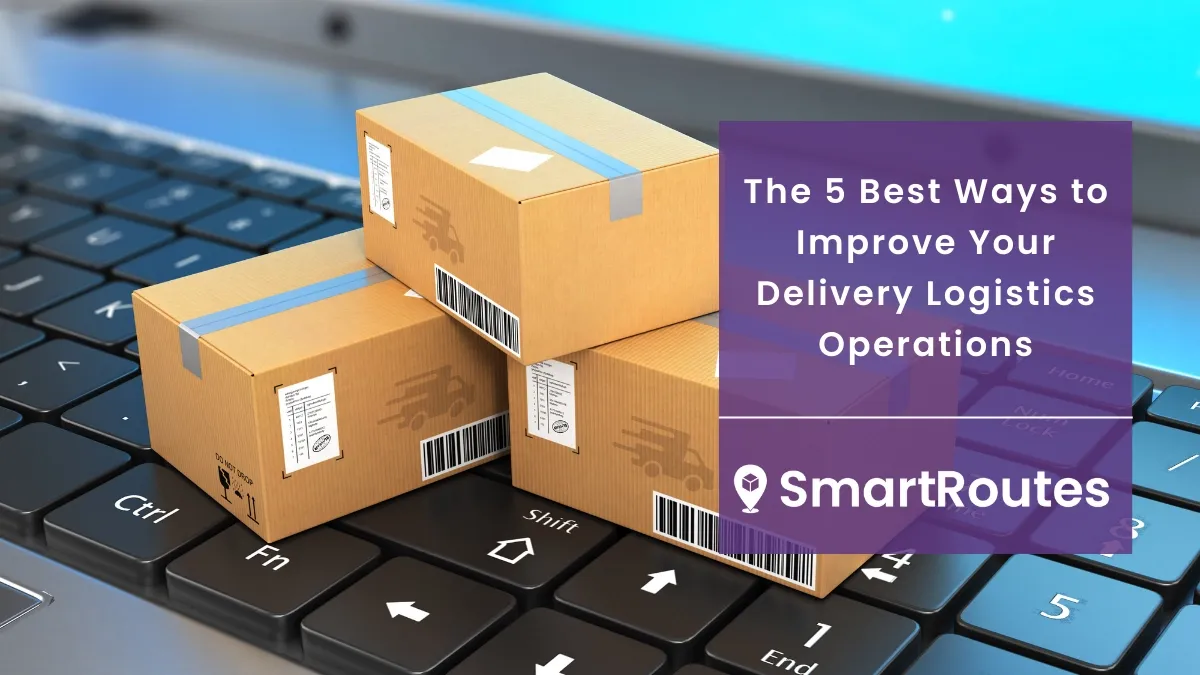8 Route Planning Tips in 2023
Efficient route planning is crucial for delivery businesses and companies handling their own deliveries. We have put together our 8 top tips to bring your route planning to the next level.

Efficient route planning is crucial for delivery businesses and companies handling their own deliveries. Optimizing routes not only reduces resource wastage but also enhances profitability and keeps customers satisfied. In this blog, we'll explore eight essential route planning tips for 2023 that will streamline your delivery operations, minimize costs, and improve overall efficiency.
With increasing customer expectations and the ever-changing landscape of logistics, mastering route planning becomes a competitive advantage. Proper route planning goes beyond plotting the shortest distance between two points; it involves a strategic orchestration of delivery routes that considers real-time factors, delivery schedules, and the capacity of your fleet.
By leveraging advanced route planning tools like SmartRoutes, businesses can revolutionize their delivery processes and stay ahead of the competition. SmartRoutes harnesses cutting-edge technologies such as artificial intelligence and predictive analytics to offer dynamic and adaptable route planning solutions. These tools empower businesses to optimize delivery routes in real-time, providing drivers with the most efficient paths to their destinations.
Let's dive into these essential tips that will reshape your route planning strategies and drive your delivery business to new heights in the year 2023.
What is Route Planning?
Route planning is a sophisticated and strategic process that lies at the heart of efficient delivery operations. It involves the planning and scheduling of the most optimized and cost-effective routes for delivery vehicles to navigate from their starting point to multiple destinations and back. Efficient route planning should minimize travel time, reduce resource wastage and ensure timely deliveries, all while considering a multitude of dynamic factors such as:
Stop Locations: Prioritizing stop locations based on proximity and clustering them geographically can lead to a reduction in travel distance and time, thus improving efficiency.
Vehicle Capacity: Understanding the capacity and capabilities of each delivery vehicle is vital. Route planners ensure that the load for each vehicle is well-balanced, maximizing the number of deliveries made in a single trip and minimizing fuel consumption.
Delivery Schedules: Coordinating multiple deliveries within specific time windows enables businesses to make the most of their fleet's capacity and minimize turnaround times.
SmartRoutes Route Planning Software
Streamline your entire delivery process, all from one platform

The Benefits of Intelligent Route Planning:
Reduce Driving Hours per Delivery: By carefully analyzing the best routes, intelligent route planning eliminates unnecessary detours and backtracking, ensuring that delivery vehicles follow the most direct paths to their destinations.
Reduced Fuel Consumption: Optimized routes lead to reduced fuel consumption, which not only contributes to cost savings but also aligns with eco-friendly practices.
Timely Deliveries: Efficient route planning ensures that deliveries are made on time, meeting customer expectations and strengthening brand reputation. Punctuality is a critical factor in customer satisfaction and retention.
Enhanced Fleet Productivity: By maximizing the efficiency of each delivery trip, route planning enables businesses to achieve more deliveries with the same fleet, resulting in enhanced fleet productivity and reduced operational costs.
Improved Customer Service: On-time deliveries and accurate ETAs (Estimated Time of Arrival) build trust with customers, encouraging repeat business and positive word-of-mouth referrals.
8 Route Planning Tips to Improve Your Delivery Process
1. Automate Importing the Data
Traditional route planning methods, reliant on manual data entry and analysis, can lead to inefficiencies and errors, particularly when handling substantial amounts of delivery data.
Automating the process of importing data directly into the route planning software revolutionizes the route planning workflow. This automation saves valuable time and resources, allowing businesses to focus on their core operations and strategic decision-making.
By integrating real-time data syncing capabilities, route planning becomes agile and adaptable. As new delivery orders come in or customer addresses change, the route planning software remains up-to-date, ensuring that the latest information is always available for analysis and optimization.
Automated data importing significantly reduces the risk of manual errors that can occur during the data entry process. Eliminating human-induced mistakes ensures that accurate information drives route planning decisions, resulting in optimized and reliable delivery routes.
2. Optimize Vehicle Capacity
By maximizing the use of delivery vehicles’ capacity, businesses can reduce the number of trips required to fulfill orders, optimize fuel consumption and ultimately enhance overall efficiency.
Regardless if you handle your own deliveries or you are a 3PL business, when it comes to delivery operations, every mile counts, and every vehicle must be utilized to its full potential. Route planners can be given the unique size and weight capacities of each vehicle in the fleet and then consider these when optimizing routes.

Employing advanced route planning tools that account for vehicle specifications is essential for effective vehicle capacity optimization. With fewer trips required to fulfill deliveries, businesses can lower fuel expenses and reduce wear and tear on their vehicles. This not only cuts operational costs but also extends the lifespan of the delivery fleet.
Moreover, enhanced vehicle capacity utilization leads to increased productivity. Drivers spend less time on the road, allowing them to focus on the actual delivery process and deliver more orders within a given timeframe.
3. Co-Ordinate Drivers based on Availability
Coordinating drivers' schedules seamlessly distinguishes an excellent delivery operation from an average one. Route planning should be factoring in drivers' schedules, businesses can optimize routes and assign deliveries in a way that minimizes waiting times, boosts overall fleet productivity, and fosters a positive work environment for their drivers.
By efficiently coordinating based on availability, you avoid overburdening certain drivers while others remain idle. This balanced approach leads to better fleet utilization, improved delivery timelines, and reduced operational costs.
Route planning software integrates real-time driver scheduling information into the route planning process. This level of automation ensures that the right driver is dispatched to the right location at the right time, streamlining the entire delivery process. It also ensures that drivers do not have to wait between deliveries or spend excessive time on the road.
Coordinating drivers based on their availability is not just about optimizing delivery schedules; it's also about prioritizing driver well-being. A balanced distribution of workloads prevents drivers from feeling overworked and fatigued, promoting a healthy work-life balance.
4. Use Technology to Improve Fleet Productivity
Embracing advanced route planning tools and leveraging cutting-edge technologies can revolutionize delivery operations, enabling them to stay agile, adaptive, and competitive in a dynamic market. By investing in technology-driven solutions, businesses can empower their fleet with real-time updates, GPS tracking, and navigation features that streamline operations, enhance decision-making, and ultimately lead to substantial cost savings and improved overall productivity.
Route planning tools that provide real-time updates ensures that drivers and dispatchers are always in the loop. Edits can be made to already dispatched routes and the route planning software will send push notifications to the drivers on the road keeping them fully informed. This level of responsiveness is instrumental in minimizing delays, reducing missed deliveries, and maintaining an efficient delivery process even in the face of unexpected challenges.

One of the cornerstones of technology-driven fleet productivity is GPS tracking and navigation features. By equipping drivers with GPS-enabled devices, delivery businesses gain real-time visibility into the location and movement of their fleet. This data provides invaluable insights, allowing dispatchers to monitor routes, identify potential bottlenecks, and proactively make adjustments to ensure optimal routing.
5. Proactively Reduce Missed Deliveries and Re-Deliveries
Missed deliveries and the need for re-deliveries can create a ripple effect of inefficiencies, wasted resources, and customer dissatisfaction. Proactively addressing these challenges is crucial for delivery operations seeking to streamline operations and provide a seamless customer experience.
Route planning software equipped with predictive analytics offers a proactive approach to address missed deliveries. By analyzing historical data and real-time information, the software can identify potential bottlenecks and challenges that might hinder successful deliveries. These insights empower businesses to make informed decisions and optimize routes before delivery drivers hit the road.
By proactively reducing missed deliveries and re-deliveries, businesses can demonstrate reliability and commitment to meeting customer expectations. Delivering orders accurately and on time leads to heightened customer satisfaction, fostering loyalty and positive word-of-mouth referrals. Satisfied customers are more likely to become repeat customers, driving long-term business growth and profitability.
6. Keep Customers in the Loop of Delivery Status
Customers have come to expect transparency and real-time updates in the delivery process. By providing clear and accurate information about the delivery status, businesses can alleviate customer anxiety and uncertainty, fostering a sense of trust and reliability.
Transparency in deliveries shows that the business values its customers and respects their time. It also demonstrates a commitment to exceptional service, which is a critical factor in customer retention and attracting new business.Route planning tools equipped with automated delivery status updates streamline the communication process between businesses and their customers. These tools leverage real-time data to provide customers with regular updates on the status of their orders.

Customers receive notifications at key milestones, such as when the order is confirmed, out for delivery, or successfully delivered. With this level of automation, businesses can keep customers informed without manual intervention, saving time and ensuring consistent communication.
When customers are kept in the loop about their delivery status, they feel empowered and informed. Knowing when to expect their orders allows them to plan accordingly, ensuring they are available to receive the delivery or make necessary arrangements. Moreover, should there be any unexpected delays or issues, proactive communication about the status allows customers to adjust their plans accordingly.
7. Account for Driver Breaks and Load Balancing
As delivery operations strive for efficiency and productivity, it's crucial to strike a balance between optimizing routes and prioritizing driver well-being. Drivers often face demanding schedules and tight deadlines. Incorporating regular breaks into their workday is not just a matter of compliance with labour regulations but also a crucial aspect of promoting driver safety and well-being. Fatigued drivers are at risk of making errors, and their physical health may suffer if they do not have adequate time to rest and recharge.
Labour regulations often stipulate mandatory rest periods for drivers, including daily breaks and maximum hours of work. Route planning should take these regulations into account to ensure that drivers have the opportunity to rest and comply with the law.
Load balancing is the strategic distribution of deliveries across the fleet to prevent any single driver from being overloaded with deliveries. Equitable distribution of workload ensures that all drivers have a manageable number of deliveries to make, reducing the risk of delays, errors, and customer dissatisfaction.
By considering factors such as driver capacity, delivery location, and delivery time frames, route planners can optimize the allocation of deliveries to ensure each driver's schedule remains balanced and manageable.
8. Track your Vehicles to Continually Make Improvements
To ensure continuous improvement, delivery businesses must leverage the valuable data collected from route planning tools and track their vehicles' performance. By regularly analyzing key performance metrics businesses can identify areas for enhancement and fine-tune their route planning strategies. Tracking vehicles empowers businesses to make data-driven decisions, maximize operational efficiency, and stay ahead of the competition in the ever-evolving landscape of the delivery industry.
Regularly analyzing performance metrics is a critical aspect of continuous improvement. Delivery times, on-time delivery rates, fuel consumption, and vehicle utilization are some of the key metrics that businesses should monitor. By closely examining these metrics, businesses can identify trends, areas of improvement, and potential roadblocks that may be hindering optimal performance.
Armed with insights from performance metrics, businesses can fine-tune their route planning strategies. Adjusting routes, revisiting delivery schedules, or deploying additional resources strategically can lead to more efficient operations. By consistently optimizing route planning strategies, businesses can drive down costs, increase delivery efficiency, and enhance customer satisfaction.
How Using Route Planning Software, like SmartRoutes, Can Improve Your Deliver Operations in 2023
Route planning software emerges as a transformative tool to revolutionize how businesses handle deliveries. SmartRoutes, powered by advanced algorithms, offers real-time tracking and data-driven insights, providing delivery operations a comprehensive solution to optimize their processes and exceed customer expectations.
By automating the route planning process, SmartRoutes saves valuable time and resources for businesses. With automated data importing and real-time data syncing, operations can be streamlined, and responses to changing demands become more agile. Reduced manual tasks and elimination of errors allow businesses to focus on core operations and strategic decision-making.
Experience the transformation SmartRoutes can bring to your delivery operations by trying our 7 day free trial. SmartRoutes is your partner in achieving efficient, customer-centric, and cost-effective delivery operations.
Frequently asked questions
1. What features should you look out for when choosing route planning software?
When choosing route planning software, consider key elements such as:
- Real-time Traffic Updates: Effective route planning software should provide real-time traffic data, enabling dynamic route adjustments to avoid congestion and delays.
- User-Friendly Interface: An intuitive, user-friendly interface is essential for ease of use and efficient route planning.
- Integration Capabilities: Check if the software can seamlessly integrate with your existing systems, such as GPS devices, fleet management software, or CRM systems.
- Reporting and Analytics: The ability to generate reports and analyze route performance is valuable for making data-driven decisions and optimizing future routes.
2. Is it possible to plan routes for multiple stops with route planning tools?
Yes, it is possible to plan routes for multiple stops with route planning tools. These tools allow you to input all your destinations, and they will calculate the most efficient sequence and path to visit each stop while minimizing travel time and distance. This feature is highly beneficial for delivery drivers, salespeople, and anyone with multiple stops on their route.
3. How can I account for specific vehicle restrictions or requirements when planning a route?
To account for specific vehicle restrictions or requirements when planning a route:
- Use route planning software that allows you to specify vehicle details such as height, weight, and vehicle type.
- Ensure the software takes these restrictions into account when generating the route.
- Set up alerts or warnings for routes that may violate vehicle constraints, helping drivers avoid issues on the road.
4. What are some cost-saving strategies for businesses using route planning software?
Businesses can implement several cost-saving strategies when using route planning software:
- Fuel Efficiency: Route planning software can optimize routes to reduce fuel consumption by choosing shorter and more fuel-efficient paths.
- Vehicle Maintenance: By minimizing excessive mileage and wear and tear on vehicles, companies can extend the lifespan of their fleet.
- Driver Productivity: Efficient routes help drivers complete more deliveries in less time, increasing productivity.
- Reduced Overtime: Better route planning can lead to fewer hours worked over the regular shift, reducing overtime costs.
If you enjoyed this blog, you might also be interested in:








